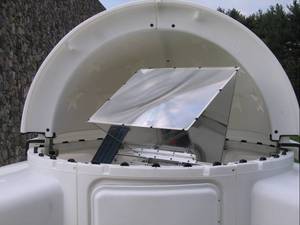
IBM researchers have achieved a breakthrough in photovoltaics technology that could significantly reduce the cost of harnessing the Sun's power for electricity.
Posted on 05/15/2008 1:24:29 PM PDT by Ernest_at_the_Beach
ARMONK, NY, May 15, 2008 IBM today announced a research breakthrough in photovoltaics technology that could significantly reduce the cost of harnessing the Sun's power for electricity.
************************snip***************************
The trick lies in IBM's ability to cool the tiny solar cell. Concentrating the equivalent of 2000 suns on such a small area generates enough heat to melt stainless steel, something the researchers experienced first hand in their experiments. But by borrowing innovations from its own R&D in cooling computer chips, the team was able to cool the solar cell from greater than 1600 degrees Celsius to just 85 degrees Celsius.
(Excerpt) Read more at marketwatch.com ...
Application of technologies developed for computers in other areas.
I wonder how much energy is consumed in the cooling process?
I don’t get the advangage. Say you have a lense 20/20 cm. You concentrate the energy falling onto 400 sq cm into a smaller area. But then you throw away a lot of that energy with the “clever” cooling technology so, what’s the point?

IBM researchers have achieved a breakthrough in photovoltaics technology that could significantly reduce the cost of harnessing the Sun's power for electricity.
bump
IMPOSSIBLE!!!!!! Rosie told me that can't be done.

Yes some energy is lost in the cooling but that percent is much smaller than the cost efficiency gained by reducing the number of cells for the same area from 400 to 1.

Why not just use a smaller lense so the temperature doesn’t rise to the point that you have to cool it?
Thanks. See my post #11.
Google paid nine figures for the development of solar cells that cost only $1 a watt, IBM paid for the most concentrated cells ever, T. Boone is taking the largest wind farm in the world online with 4 GW in three years.
And the left says government is necessary to advance the state of the art in renewable energy to save us from Global Warming. What has the government given us? Economic waste, plans that hurt more than they help. What has private industry given us? See above.
American ingenuity rules.
Smaller lens means that you then collect less sunlight on the specific cell. Yes that is less heat, but now you have to have more cells for the same given area and thus reduce your cost efficiency.
If it's a heat pipe, zero energy is consumed and the transferred energy can be used to heat water. Heat pipes are extremely efficient at transferring heat and they do it passively.

LOL! (chocking on coffee). I wouldn’t touch California with a ten foot pole. I meant fresnel.
Another company is developing mylar balloons to use as magnifiers over PV cells. Cheap, easy to handle, replaceable. But they would might melt if put over a 85C surface day in day out?
Youtube video of their demo project:
http://www.youtube.com/watch?v=kROgE4Jdm-k
homepage:
http://coolearthsolar.com/
Disclaimer: Opinions posted on Free Republic are those of the individual posters and do not necessarily represent the opinion of Free Republic or its management. All materials posted herein are protected by copyright law and the exemption for fair use of copyrighted works.